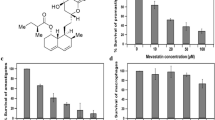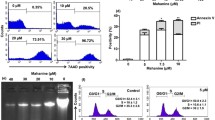Abstract
Leishmania establishes a successful parasitism by evading both oxidative and non-oxidative killing pathways, and its drug resistance against the currently available therapeutics demands for a safe and cheap drug. Since the parasite synthesizes ergosterol instead of cholesterol, using the same biochemical pathway and enzymes, an inhibitor of HMG-CoA-Reductase, Lovastatin, has been tried for its anti-Leishmanial effect. Lovastatin, being an inhibitor of HMG-CoA-Reductase, inhibits infection by cholesterol depletion, while chromium chloride complexes, at their higher concentrations, are reported to exhibit cytotoxicity. In intracellular amastigotes, cytotoxicity has been checked by assessing various manifestation of cell death, viz. DNA fragmentation, AnnexinV-FITC binding and JC-1 fluorescence ratio. Release of hydrogen peroxide (HPO) and nitric oxide (NO) has been assessed in live cell. Lovastatin and CrCl3.6H2O in combination has appeared to be ineffective on promastigotes but has induced cytotoxic effect on the intracellular amastigotes through up-regulation of cellular signalling mechanisms. CrCl3.6H2O stimulates generation of NO, leading to reduction of the number of intracellular amastigote, while Lovastatin shows HPO-mediated killing of the same, keeping the host cell unaffected. This novel therapeutic approach, involving two known safe compounds in suboptimal doses, may resolve human visceral Leishmaniasis.






Similar content being viewed by others
References
Aditya Kumar G, Jafurulla M and Chattopadhyay A 2016a The membrane as the gatekeeper of infection: cholesterol in host–pathogen interaction. Chem. Phys. Lipids 199 179–185
Aditya Kumar G, Roy S, Jafurulla M, Mandal C and Chattopadhyay A 2016b Statin-induced chronic cholesterol depletion inhibits Leishmania donovani infection: relevance of optimum host membrane cholesterol. Biochim. Biophys. Acta 1858 2088–2096
Al-Mulla Hummadi YM, Al-Bashir NM and Najim RA 2005 The mechanism behind the antileishmanial effect of zinc sulphate. II. Effects on the enzymes of the parasites. Ann. Trop. Med. Parasitol. 99 131–139
Bagchi D, Stohs SJ, Downs BW, Bagchi M and Preuss HG 2002 Cytotoxicity and oxidative mechanisms of different forms of chromium. Toxicology 180 5–22
Balamurugan K, Rajaram R, Ramasami T and Narayanan S 2002 Chromium(III)-induced apoptosis of lymphocytes: death decision by ROS and Src-family tyrosine kinases. Free Radic. Biol. Med. 33 1622–1640
Beck H-P 2002 Extraction and purification of plasmodium parasite DNA. Methods Mol. Med. 72 159–163
Chakravarty J and Sundar S 2010 Drug resistance in leishmaniasis. J. Glob. Infect. Dis. 2 167–176
Crane FL 2001 Biochemical functions of coenzyme Q10. J. Am. Coll. Nutr. 20 591–598
Croft SL, Sundar S and Fairlamb AH 2006 Drug resistance in leishmaniasis. Clin. Microbiol. Rev. 19 111–126
Delbosc S, Morena M, Djouad F, Ledoucen C, Descomps B and Cristol J-P 2002 Statins, 3-hydroxy-3-methylglutaryl coenzyme A reductase inhibitors, are able to reduce superoxide anion production by NADPH oxidase in THP-1-derived monocytes. J. Cardiovasc. Pharmacol. 40 611–617
Doeller JE, Isbell TS, Benavides G, Koenitzer J, Patel H, Patel RP, Lancaster JR, Darley-Usmar VM and Kraus DW 2005 Polarographic measurement of hydrogen sulfide production and consumption by mammalian tissues. Anal. Biochem. 341 40–51
Ghosh AK, Bhattacharyya FK, Ghosh DK 1985 Leishmania donovani: amastigote inhibition and mode of action of berberine. Exp. Parasitol. 60, 404–413
Ghosh M, Pal C, Ray M, Maitra S, Mandal L and Bandyopadhyay S 2003 Dendritic cell-based immunotherapy combined with antimony-based chemotherapy cures established murine visceral leishmaniasis. J. Immunol. 170 5625–5629
Ghosh M, Mandal L, Maitra S, Rakshit S, Paul K, Bagchi J, Ganguly D, Pal C and Bandyopadhyay S. (2006) Leishmania donovani infection of human myeloid dendritic cells leads to a Th1 response in CD4+ T cells from healthy donors and patients with kala-azar. J. Infect. Dis. 194 294–301
Gimpl G 2010 Cholesterol-protein interaction: methods and cholesterol reporter molecules. Subcell. Biochem. 51 1–45
Jayanarayan KG and Dey CS 2005 Altered tubulin dynamics, localization and post-translational modifications in sodium arsenite resistant Leishmania donovani in response to paclitaxel, trifluralin and a combination of both and induction of apoptosis-like cell death. Parasitology 131 215–230
Kaur J, Dutta S, Chang K-P and Singh N 2013 A member of the Ras oncogene family, RAP1A, mediates antileishmanial activity of monastrol. J. Antimicrob. Chemother. 68 1071–1080
Kettawan A, Takahashi T, Kongkachuichai R, Charoenkiatkul S, Kishi T and Okamoto T 2007 Protective effects of coenzyme Q(10) on decreased oxidative stress resistance induced by simvastatin. J. Clin. Biochem. Nutr. 40 194–202
Khoo’ SH, Bond J and Denning DW 1994 Administering amphotericin B—a practical approach. J. Antimicrob. Chemother. 33 203–213
Levis AG and Majone F 1979 Cytotoxic and clastogenic effects of soluble chromium compounds on mammalian cell cultures. Br. J. Cancer 40 523–533
Liao JK and Laufs U 2005 Pleiotropic effects of statins. Annu. Rev. Pharmacol. Toxicol. 45 89–118
Lodge R, Diallo TO and Descoteaux A 2006 Leishmania donovani lipophosphoglycan blocks NADPH oxidase assembly at the phagosome membrane. Cell. Microbiol. 8 1922–1931
Ma JA, Chapman GV, Chen SL, Penny R and Breit SN 1987 Flow cytometry with crystal violet to detect intracytoplasmic fluorescence in viable human lymphocytes. Demonstration of antibody entering living cells. J. Immunol. Methods 104 195–200
McDowell MA, Marovich M, Lira R, Braun M and Sacks D 2002 Leishmania priming of human dendritic cells for CD40 ligand-induced interleukin-12p70 secretion is strain and species dependent. Infect. Immun. 70 3994–4001
Moore EM and Lockwood DN 2010 Treatment of visceral leishmaniasis. J. Glob. Infect. Dis. 2 151–158
Mukherjee M, Basu Ball W and Das PK 2014 Leishmania donovani activates SREBP2 to modulate macrophage membrane cholesterol and mitochondrial oxidants for establishment of infection. Int. J. Biochem. Cell Biol. 55 196–208
Mukherjee S, Mukherjee B, Mukhopadhyay R, Naskar K, Sundar S, Dujardin JC, Das AK, Roy S, Clem A, Sundar S, et al. 2012 Imipramine is an orally active drug against both antimony sensitive and resistant Leishmania donovani clinical isolates in experimental infection. PLoS Negl. Trop. Dis. 6 e1987
Pucadyil TJ and Chattopadhyay A 2007 Cholesterol: a potential therapeutic target in Leishmania infection? Trends Parasitol. 23 49–53
Reis LC, Ramos-Sanchez EM and Goto H 2013 The interactions and essential effects of intrinsic insulin-like growth factor-I on Leishmania (Leishmania) major growth within macrophages. Parasite Immunol. 35 239–244
Roberts CW, McLeod R, Rice DW, Ginger M, Chance ML and Goad LJ (2003) Fatty acid and sterol metabolism: potential antimicrobial targets in apicomplexan and trypanosomatid parasitic protozoa. Mol. Biochem. Parasitol. 126 129–142
Roy K, Mandloi S, Chakrabarti S and Roy S 2016 Cholesterol corrects altered conformation of MHC-II protein in Leishmania donovani infected macrophages: Implication in therapy. Biochimica et Biophysica Acta. 1858 2088–2096
Roychoudhury J and Ali N 2008 Sodium stibogluconate: therapeutic use in the management of leishmaniasis. Indian J. Biochem. Biophys. 45 16–22
Sharma U and Singh S 2009 Immunobiology of leishmaniasis. Indian J. Exp. Biol. 47 412–423
Verma NK and Dey CS 2004 Possible mechanism of miltefosine-mediated death of Leishmania donovani. Antimicrob. Agents Chemother. 48 3010–3015
Wortmann G, Zapor M, Ressner R, Fraser S, Hartzell J, Pierson J, Weintrob A and Magill A 2010 Lipsosomal amphotericin B for treatment of cutaneous leishmaniasis. Am. J. Trop. Med. Hyg. 83 1028–1033
Acknowledgements
We acknowledge Dr Santu Bandyopadhyay, Chief Scientist, Indian Institute of Chemical Biology, Jadavpur, Kolkata, for his support in FACS analysis. We also acknowledge Dr Nahid Ali, Ms Roma Sinha and Mr Anirban Manna, Indian Institute of Chemical Biology, Jadavpur, Kolkata, for their support and for providing L. donovani AG83-sensitive strain used in this study. We also acknowledge Department of Biotechnology (DBT) (Grant No. BT/PR15025/GBD/27/284/2010 (Order-I) dated 16.06.2011), India, for their financial support in this study.
Author information
Authors and Affiliations
Corresponding author
Additional information
Corresponding editor: Amit Chattopadhyay
Electronic supplementary material
Below is the link to the electronic supplementary material.
Rights and permissions
About this article
Cite this article
Verma, A.K., Laha, B., Pandey, M. et al. Cholesterol-lowering drug, in combination with chromium chloride, induces early apoptotic signals in intracellular L. donovani amastigotes, leading to death. J Biosci 42, 427–438 (2017). https://doi.org/10.1007/s12038-017-9690-9
Received:
Accepted:
Published:
Issue Date:
DOI: https://doi.org/10.1007/s12038-017-9690-9




